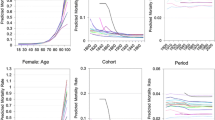Abstract
Researchers often describe population aging with measures such as proportion of population under 15 years of age, proportion of population 65 years and over, the aged-child ratio (a ratio of the first two measures), median age, and mean age. Investigators of cross-cultural gerontology, too, use such measures to compare population aging between populations. While insights from comparing only the values of an aging measure between two populations may be helpful, results from such comparison can be misleading due to the influences of fertility, mortality, and migration. To show the effects of these demographic processes on measures of population aging, rates of change in five measures of population aging as a function of fertility, mortality, and migration are developed. These rates of change are estimated for various stable populations, for stable populations disequilibrated by fertility and mortality declines and by net migration, and for the population in Japan, 1988–1989. The findings demonstrate that the five aging measures, in general, do not give consistent rate-of-change estimates; they also suggest that directly comparing values of aging measures without considering the levels and patterns of fertility, mortality and migration will lead to misleading conclusions.
Similar content being viewed by others
References
Coale, A.J. (1972) The Growth and Structure of Human Populations: A Mathematical Investigation. Princeton: Princeton University Press.
Coale, A.J. & P. Demeny (1983) Regional Model Life Tables and Stable Populations. New York: Academic Press.
Espenshade, T.J. (1984) Comment on Mitra's Generalization, Demography 21: 431–432.
Espenshade, T.J., L.F. Bouvier & B.W. Arthur (1982) Immigration and the Stable Population Model, Demography 19: 125–133.
Japan Statistics Bureau, Management and Coordination Agency (1991) Japan Statistical Yearbook 1991. Tokyo: Japan Statistical Association.
Keyfitz, N. (1968) Introduction to the Mathematics of Population. Reading, MA: Addison-Wesley.
Keyfitz, N. (1997) Applied Mathematical Demography. New York: Wiley.
Lutz, W. (1994) The Future of World Population, Population Bulletin 49(1).
Mitra, S. (1983) Generalization of the Immigration and the Stable Population Model, Demography 20: 111–115.
Mitra, S. (1984) on Espenshade's Comments on Mitra's Generalization, Demography 21: 433–434.
Preston, S.H., C. Himes & M. Eggers (1989) Demographic Conditions Responsible for Population Aging, Demography 26: 691–704.
Shryock, H.S. & J.S. Siegel (1976) The Methods and Materials of Demography. Condensed Edition. New York: Academic Press.
Author information
Authors and Affiliations
Rights and permissions
About this article
Cite this article
Liao, T.F. Measuring population aging as a function of fertility, mortality, and migration. J Cross-Cultural Gerontol 11, 61–79 (1996). https://doi.org/10.1007/BF00116265
Issue Date:
DOI: https://doi.org/10.1007/BF00116265




